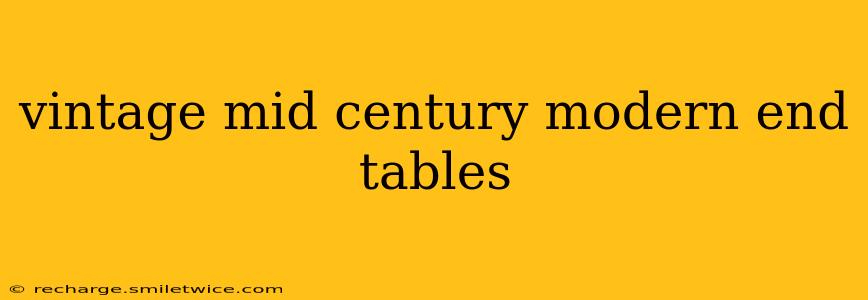The allure of vintage mid-century modern (MCM) furniture is undeniable. Its clean lines, organic shapes, and emphasis on functionality continue to captivate design enthusiasts. Among the most sought-after pieces are vintage mid-century modern end tables, offering both practical storage and a statement piece for any living room or bedroom. This guide explores everything you need to know about finding, identifying, and caring for these iconic pieces.
What Defines a Mid-Century Modern End Table?
Before diving into the specifics, let's establish what characteristics define a vintage MCM end table. These tables generally fall within the timeframe of 1933 to 1965, although some pieces extend slightly beyond those years. Key features include:
- Simple, clean lines: Avoidance of excessive ornamentation is a hallmark.
- Organic shapes: Often incorporating curves and tapered legs.
- High-quality materials: Solid wood (teak, walnut, rosewood are common), and sometimes metal or glass.
- Functionality: Designed to be both aesthetically pleasing and practical.
- Minimalist aesthetic: A focus on form and function over elaborate details.
What are some Popular Mid-Century Modern End Table Styles?
Several distinct styles emerged within the mid-century modern movement, leading to a diverse range of end table designs. Popular styles include:
- Danish Modern: Known for its clean lines, simple forms, and use of light-colored woods like teak and beech.
- Atomic Age: Characterized by bold geometric shapes, playful use of color, and often incorporating materials like chrome and plastic.
- American Modern: Often featuring a blend of styles, incorporating elements of both Danish Modern and the Atomic Age. Materials like walnut and other American hardwoods are common.
How can I Identify Authentic Mid-Century Modern End Tables?
Identifying authentic MCM end tables requires careful examination. Look for these clues:
- Maker's marks: Many reputable manufacturers included labels or stamps. Researching these marks can help authenticate the piece and determine its maker.
- Construction quality: High-quality construction is a hallmark of authentic MCM furniture. Check for solid wood joinery, well-finished surfaces, and durable materials.
- Design details: Pay attention to the overall design aesthetic—clean lines, organic shapes, and minimal ornamentation.
- Hardware: Original hardware, if present, can be a strong indicator of authenticity.
Where Can I Find Vintage Mid-Century Modern End Tables?
Several avenues exist for finding your perfect MCM end table:
- Online marketplaces: Websites like eBay, Etsy, and Chairish are treasure troves of vintage furniture.
- Antique shops and flea markets: These offer opportunities to discover unique pieces and often negotiate prices.
- Estate sales: These can yield hidden gems at affordable prices.
- Consignment shops: Specializing in vintage and antique furniture, they often curate high-quality selections.
How Much Do Vintage Mid-Century Modern End Tables Cost?
Pricing varies greatly depending on factors like maker, condition, materials, and rarity. Expect to pay anywhere from a few hundred dollars for a more common piece to several thousand for a rare or highly sought-after example. Condition is a critical factor – a well-preserved piece will command a higher price than one needing significant restoration.
How Do I Care for My Vintage Mid-Century Modern End Table?
Proper care ensures your investment remains beautiful for years. Follow these tips:
- Dust regularly: Use a soft cloth or duster to prevent dust buildup.
- Avoid harsh chemicals: Use mild cleaners and avoid abrasive materials that could scratch the finish.
- Protect from direct sunlight: Prolonged exposure to sunlight can fade the finish.
- Use coasters and placemats: Protect the surface from scratches and water damage.
- Consider professional restoration: If necessary, consult a professional furniture restorer for significant repairs or refinishing.
What are some common materials used in Mid-Century Modern End Tables?
Several materials were popular choices during the mid-century modern era, each contributing to the distinctive style of the furniture.
- Teak: A durable hardwood known for its rich golden brown color and beautiful grain.
- Walnut: Another popular hardwood, prized for its deep brown tones and fine grain.
- Rosewood: A luxurious hardwood with a stunning reddish-brown hue and striking grain pattern.
- Chrome: Often used for legs and other accents, adding a touch of industrial chic.
Are reproductions a good alternative to vintage MCM end tables?
Reproductory pieces offer a more affordable option for those seeking the MCM aesthetic without the price tag of vintage originals. However, it is important to distinguish between high-quality reproductions that faithfully replicate the original design and lower-quality imitations. The craftsmanship and materials used will vary significantly, impacting both the appearance and longevity of the piece.
By understanding the characteristics, identifying features, and care requirements of vintage mid-century modern end tables, you can confidently embark on your search for the perfect piece to complement your home. Happy hunting!
